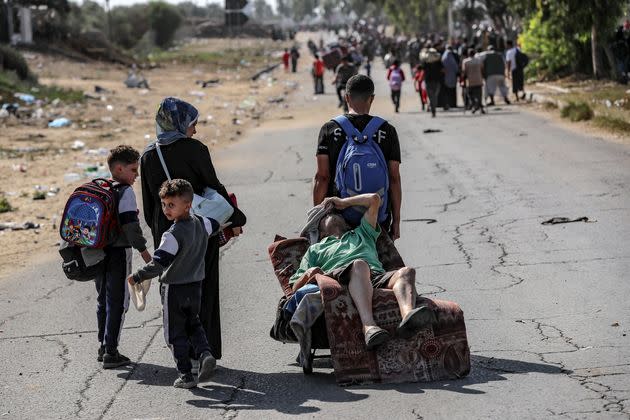Who ‘Would Accept Such A Life?’ Gaza Conditions Worsen As U.S. Aid Comes Up Short
November 11th, 2023Sakhr Humaid received the call from the Israel Defense Forces telling him to evacuate not once but twice.
On the afternoon of Oct. 7, an Israeli airstrike hit the home in Gaza City where Humaid lived with his wife, elderly parents, five children and three siblings. The blast brought down their roof, but they survived. The following day brought the first Israeli call: Leave or face more bombs.
They grabbed the few belongings they could take with them and traveled 15 miles to the southern city of Khan Yunis. After a week, they got an eerily familiar message: another Israeli call to leave.
The Humaid family headed to Rafah, the Gazan city on the strip’s border with Egypt. They are one of five families now sheltering at a friend’s home there, joining nearly 600,000 people who have left northern Gaza following a broad Israeli order on Oct. 13 to leave the north within 24 hours.
“The situation is worse than we ever imagined or lived before,” Humaid told HuffPost, saying he cannot find enough food or drink for his children ― all younger than 12 ― or his elderly parents. “It’s a scary situation, one of terror and worry and an extreme fear over one’s life.”
Five weeks into the Israeli offensive in the Gaza Strip, the global conversation about the conflict largely focuses on the humanitarian crisis in the region ― and how it is rapidly worsening despite claims by Israel and its most important backer, the U.S., that the campaign is prioritizing the protection of civilians.
Israeli and American officials are rejecting public calls for a cease-fire, including from the United Nations, by saying Israel must move fast to punish the Gaza-based militant group Hamas for its Oct. 7 attack inside the country. They argue that the operation can continue and avoid unnecessary damage, citing measures like a recently announced plan for brief daily pauses in bombing in some parts of the Palestinian enclave of Gaza to let aid in and let civilians leave, and intensive diplomacy at the strip’s southern border with Egypt to allow more aid trucks to enter.
But humanitarian groups and people inside Gaza say the evidence shows those steps are far from sufficient.
Secretary of State Antony Blinken says the U.S. is leading talks to get supplies across the Rafah Crossing, the only entry point into Gaza that is not controlled by Israel. Negotiations over the crossing are complex: Israel has repeatedly bombed it and says it must check the supplies that pass through to ensure they do not contain materials that could bolster Hamas, and Egyptian and Hamas officials have a say over whether the crossing remains functional.
On Oct. 31, Blinken said “the bare minimum of what’s needed” is for 100 trucks a day to bring in aid through Rafah. On Nov. 3, he said the daily figure of trucks making the crossing exceeded 100, and on Nov. 5, he said it was “about a hundred.”
Yet data gathered by a United Nations-led logistics tracker and viewed by HuffPost tells a different story.
Only 47 trucks were approved to unload aid into Gaza on Nov. 3, only 30 on Nov. 4 and only 25 on Nov. 5. Since Blinken identified his daily goal, there have only been two days when about 100 trucks’ worth of aid entered Gaza: Nov. 2 and Nov. 8, according to the logistics tracker. On Nov. 9, 75 trucks’ worth of aid was planned but only 39 were actually able to deliver supplies, the data shows. The planned figure for Nov. 10 was only 30. (No confirmation was available yet for Friday on how many trucks were able to actually offload supplies, which usually include necessities such as food and medical equipment.)
A State Department spokesperson conceded that the process is not yet working as intended.
“On several days in the past week, partners have succeeded in moving more than 100 trucks into Gaza via Rafah… we are working on mechanisms to consistently surpass 100 trucks a day,” the spokesperson said via email. “We are committed to ensure that progress is sustained, and continues to be expanded upon in the days to come. The trendline is up some days and down some daysgiven complex logistics involved, but overall, the amount of aid getting into Gaza is increasing and we continue to advocate for more throughput to provide urgently needed reliefto civilians in Gaza.”
Nearly 70% of Gaza’s population of 2.3 million people has been internally displaced. More than half of those civilians are sheltering in southern areas, such as Khan Younis and Rafah, where water is now extremely scarce and there is a severe shortage of the fuel needed for water pumps and generators at hospitals and other facilities.
More people are en route to those overwhelmed areas, per Israeli orders: Between 50,000 and 80,000 Gazans fled south on foot on Thursday amid high temperatures, the U.N. reported. Shelters are overcrowded, bread and basic necessities are disappearing from the markets, and a public health crisis is growing as thousands of cases of acute respiratory illness, skin infections and diarrhea are being reported, according to local health officials.

A Palestinian family travels on foot out of northern Gaza on Nov. 10.
Being in southern Gaza is degrading and scary, and it offers no guarantee of protection, Gazans say. Israeli airstrikes continue to affect even that region, with one hitting a mosque in Khan Yunis on Thursday and damaging U.N. schools and a health center.
“We are living, waiting for death to come in any minute,” Humaid said. “There is no safe place.”
Meanwhile, hundreds of thousands of civilians remain in northern Gaza, where Israeli ground forces are amassing. The U.S.-Israel agreement on daily “pauses” in the offensive will let many of them safely leave, officials argue, but many observers say the plan still involves unacceptable risks.
“Civilians remaining in northern Gaza may do so for a variety of reasons: Physical disability, professional duty, attachment to home, and fear of inability to return and concerns about unacceptable conditions in southern Gaza are just a few of the most common,” Scott Paul of Oxfam America told HuffPost.
“Civilians who choose to move [out of northern Gaza] during pauses are not leaving voluntarily, and civilians who stay retain their protection” under the law of war. The pauses also will not guarantee safety for aid workers who seek to support the community, said Tjada D’Oyen McKenna, the chief executive officer of the humanitarian group Mercy Corps, in a Friday statement.
Some experts worry Israel will use the pause plan to treat all of northern Gaza as a war zone and reject limits on its actions there. On Friday, Israeli forces repeatedly damaged hospitals in the area where many locals are seeking refuge, Gaza officials said; Israel argues Hamas is using those facilities for military purposes. Israeli strikes have repeatedly hit civilians attempting to move south within Gaza.
In a Tuesday recording shared with HuffPost, Oxfam worker Alhasan Swairjo said the situation in the north was near “collapse,” with bodies in the streets, little food available and people trying to loot what supplies remain. “People are really suffering in Gaza City,” he said.
Humaid said he does not understand how the world is letting the appalling situation persist.
“How is this life? Who among them, Americans, would accept such a life? A life without water, food and homes that are destroyed?” he asked. “Where is the rights of a human being?”
Scarcity Today, Fear For Tomorrow
Every day, Palestinians are either losing homes entirely to bombing or choosing to abandon them, passing corpses and debris as they flee on foot.
“This is a new nakba,” Humaid said, a reference to the violent displacement of Palestinians amid Israel’s founding in 1948 that pushed 700,000 people out of their homes ― many, like his family, into Gaza.
Many Palestinians worry history is repeating itself and that Gazans will lose beloved homes and communities, as their ancestors did.
Those fears are not unfounded. Israel has imposed strict limits on construction supplies entering Gaza, and Prime Minister Benjamin Netanyahu’s far-right government has prevented Palestinians from constructing or even amending their homes, all while allowing for illegal settlements on occupied Palestinian territory to expand. Israeli authorities demolished, forced people to demolish or seized 290 Palestinian-owned structures across the West Bank during the first few months of 2023 alone, displacing more than 400 people, including 194 children.
In Gaza, many fear a similar fate as Israeli forces operate in the strip in a way unseen in nearly 20 years. On Friday, Netanyahu reiterated his view that Israel will remain in control of the region after the war.
I’m not aware that the [U.S. Agency for International Development] has the depth or experience to realistically plan for a post-war Gaza.Dave Harden, former USAID official responsible for the West Bank and Gaza.
The Biden administration’s mixed messaging has helped stoke those fears. David Satterfield, a former ambassador whom President Joe Biden appointed as a special Middle East humanitarian envoy amid the war, raised the idea of moving Gaza civilians into Egypt during a high-level meeting last month, a U.S. official in the meeting told HuffPost.
Satterfield has since “backed off” the proposal, the official said, and Biden has publicly rejected the idea of a population transfer across the Egyptian border.
“This reporting is false,” State Department spokesperson Vedant Patel argued in an email to HuffPost. “Special Envoy Satterfield has vociferously been against this, has not raised this as [a] policy consideration in any meeting, and has reiterated publicly and privately that the U.S. does not support forcible displacement of Palestinians from Gaza. Not now, not after the war.”
The U.S. is widely seen as a key decision-maker in Gaza’s future. Yet that reality coexists with a widespread sense that Washington is doing little to prepare for reconstruction after Israel concludes its operation, risking long-term suffering for Gazans and a prolonged disaster that could help militants regroup.
Multiple U.S. officials at agencies that would normally be involved in emergency response situations like the current Gaza dilemma told HuffPost they are not yet seeing the kind of strategizing that would be necessary for stability. The Biden administration is bypassing normal consultation processes in its current policy on the Israeli-Palestinian conflict, many officials say, expressing frustration that their foreign policy expertise is not being tapped.
“Post-Hamas planning is going to be exceedingly complicated,” said Dave Harden, a retired diplomat who ran the U.S. Agency for International Development’s operations in the Palestinian territories, including the Gaza Strip, from 2013 to 2016. Referring to USAID, the government’s chief humanitarian agency, he told HuffPost: “I’m not aware that the agency has the depth or experience to realistically plan for a post-war Gaza.”
Washington is currently using only a small amount of its leverage over Israel to advance its stated humanitarian goals, observers say.
One sign of progress would be if the U.S. successfully pushed Israel to accept a U.N. mechanism to vet supplies for Gaza that would work more quickly, said Jesse Marks of the nonprofit Refugees International, who noted that similar mechanisms have proved capable of tracking sensitive shipments, such as fuel transfers, amid other wars.
“Israel hasn’t allowed any of that process to move forward,” Marks said.
Israeli officials say a U.N.-directed mechanism could be less intensive than their own and help Hamas access humanitarian assistance, yet they have not tested the proposed mechanism, he added.
“The Biden administration… needs to be forward-leaning in enabling the U.N. to play a larger role,” Marks said.
He described U.S. diplomacy around aid as less effective in the context of the current war than it has been elsewhere because American officials are not strongly advocating for Israel to follow international humanitarian law. Blinken and other top administrative officials have said they expect that adherence but have not suggested there would be consequences if Israel fails to abide by those norms, for instance by disproportionately killing civilians.
Many officials and analysts have expressed fears that if Biden does not shift his approach to Gaza to more firmly urge Israeli restraint, there could be dire consequences far beyond the strip.
Dozens of U.S. officials who are focused on counterterrorism wrote to the head of their agency this week urging them to press Biden to do more to shield civilians, according to an internal message seen by HuffPost. Their message warned that Washington could lose support for counterterrorism work from other countries and noted that U.S. enemies could effectively cite Gazans’ suffering to incite violence; it highlighted recent attacks on American troops stationed in Iraq. (HuffPost is not identifying the agency to protect the identities of officials who risk retaliation for expressing dissent.)
One signatory described the crisis as a global “mass radicalization event.”
“There is a cost to supporting Israel with zero limits while they conduct a mass slaughter with our weapons, and I’m not sure Americans understand the future risks and threats that Joe Biden is signing us up for,” that signatory, a U.S. official, told HuffPost.
The White House did not respond to a request for comment on the message seeking greater action from the president.
For Gazans, the global stakes matter less than just stopping the daily pain.
Describing “polluted water” and sheltering in a neighborhood where each home is hosting 30 to 40 people while being unable to secure fuel, Oxfam worker Khloud Jwefil said this week in a recording shared with HuffPost that her chief goal “is to survive the day.”
“We really wish this to come to its end because we don’t want to have more loss of everything,” Jewil said.
Related…
Disclaimer/Note: TGM Radio’s latest news posts are a collection of curated and aggregated, fresh content from the best news sources across the globe.
Tags: sports





